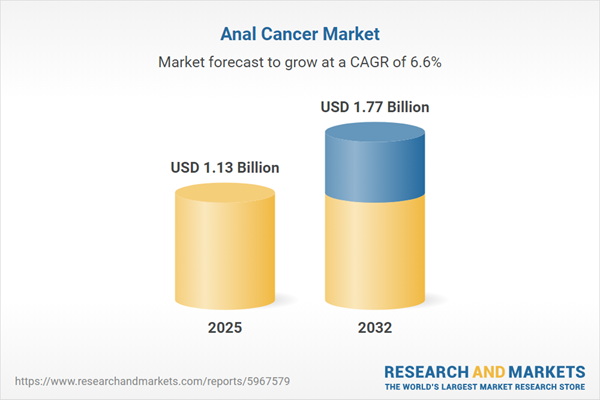Speak directly to the analyst to clarify any post sales queries you may have.
Senior executives overseeing strategies in the anal cancer market face complex clinical progress, regulatory variability, and changing delivery models. Accurate market intelligence is essential for aligning organizational priorities, navigating risks, and sustaining competitive resilience across this specialized healthcare sector.
Anal Cancer Market Snapshot: Growth, Size, and Opportunities
The anal cancer market is experiencing sustained expansion globally, projected to grow from USD 1.06 billion in 2024 to USD 1.13 billion in 2025, with expectations to exceed USD 1.77 billion by 2032 at a 6.58% compound annual growth rate. This growth is fueled by rising incidence rates, strengthened early detection initiatives, and widening access to new-generation oncology treatments. Continuous advances in care protocols, increasing patient numbers, and the prioritization of patient-centered outcomes are reinforcing the need for digital transformation, operational realignment, and focused investments.
Scope & Segmentation of the Anal Cancer Market
This research delivers strategic segmentation to help decision-makers recognize opportunity shifts and deploy resources for optimal effect amid rapid innovation:
- Treatment Type: Chemotherapy, immunotherapies (checkpoint inhibitors, vaccines), radiotherapy, minimally invasive surgeries, targeted therapies (such as EGFR inhibitors) all contribute to tailored patient management and new clinical solutions.
- End User: Ambulatory surgical centers, outpatient clinics, diagnostic labs, oncology teams, general hospitals, and comprehensive cancer centers each influence care delivery patterns, resource use, and patient experience.
- Therapeutic Line: First-line and later therapies using single agents or combinations help clinicians develop personalized care plans and streamline evidence-based practices.
- Disease Stage: Differentiated protocols are required for early versus advanced cases, supporting customization of interventions and strategic allocation of support resources.
- Administration Mode: Intravenous, oral, and topical therapies offer flexible options to address both clinical effectiveness and operational efficiencies.
- Cancer Type: Subtypes—adenocarcinoma, melanoma, squamous cell carcinoma—inform investment in precision diagnostics and direct research priorities in targeted therapies.
- Distribution Channel: Hospital pharmacies, retail settings, and online platforms enable a wide reach, shaping channel selection and access strategies across different markets.
- Regions: Americas, Europe, Middle East & Africa, and Asia-Pacific present varied regulatory landscapes, infrastructure maturity, and payer dynamics affecting market approaches and entry timelines.
- Leading Companies: Merck & Co., Bristol-Myers Squibb, Varian Medical Systems, Siemens Healthineers, Pfizer, and Johnson & Johnson illustrate the wide range of corporate models driving product development and pipeline expansion in this space.
Key Takeaways: Strategic Insights for Leaders
- Adoption of immunotherapies and targeted treatments requires adaptable care pathways, guiding organizations toward flexible service delivery and improved patient experiences.
- Strengthening supply chain management—by cultivating supplier networks and agile sourcing—reduces risks in the face of global distribution pressures and enhances operational continuity.
- Leveraging real-world evidence enables timely regulatory adaptation, improves compliance, and supports early intervention in response to emerging clinical trends.
- Collaboration among biopharma firms, technology providers, research institutions, and patient advocacy groups fosters advancements in biomarker analytics and proactive screening.
- To support operational resilience, refining market access policies and reimbursement strategies in line with local payer requirements remains vital amid evolving procurement practices.
- Segmenting investments by therapy type, cancer stage, and administration channel increases resource efficiency and ensures adaptive investment that aligns with clinical priorities.
Tariff Impact: Navigating U.S. Policy in Supply Chains
Recent U.S. tariff adjustments have raised costs and complicated logistics for oncology medicines and devices. Healthcare entities are responding by streamlining procurement, reinforcing supplier relationships, and pioneering fresh distribution models. These actions stabilize supply chains and help mitigate cross-border risks in delivery and operational continuity.
Methodology & Data Sources
This report is grounded in clinical registry outcomes, expert interviews from top oncology practitioners, and comprehensive regulatory audits. Findings are authenticated through external panel review and a detailed literature assessment to ensure actionable and up-to-date insights for executives.
Why This Report Matters
- Equips leaders to proactively address regulatory and reimbursement changes while supporting effective therapy integration.
- Offers segment-based intelligence for improved risk oversight, procurement planning, and decision-making at each organizational level.
- Translates sector complexity into practical recommendations, enabling enhanced performance and patient outcomes across the anal cancer ecosystem.
Conclusion
This analysis enables senior executives to identify emerging prospects, optimize strategies, and maintain informed advancement as the global oncology environment transforms.
Additional Product Information:
- Purchase of this report includes 1 year online access with quarterly updates.
- This report can be updated on request. Please contact our Customer Experience team using the Ask a Question widget on our website.
Table of Contents
3. Executive Summary
4. Market Overview
7. Cumulative Impact of Artificial Intelligence 2025
Companies Mentioned
The companies profiled in this Anal Cancer market report include:- Merck & Co., Inc.
- Bristol-Myers Squibb Company
- Varian Medical Systems, Inc.
- Elekta AB (publ)
- Siemens Healthineers AG
- General Electric Company
- Pfizer Inc.
- GlaxoSmithKline plc
- Johnson & Johnson
- Koninklijke Philips N.V.
Table Information
| Report Attribute | Details |
|---|---|
| No. of Pages | 198 |
| Published | October 2025 |
| Forecast Period | 2025 - 2032 |
| Estimated Market Value ( USD | $ 1.13 Billion |
| Forecasted Market Value ( USD | $ 1.77 Billion |
| Compound Annual Growth Rate | 6.5% |
| Regions Covered | Global |
| No. of Companies Mentioned | 11 |









